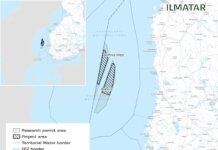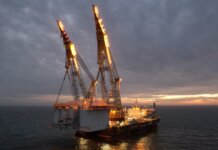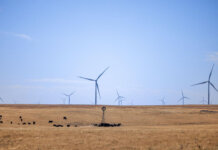The U.S. Department of Energy (DOE) and Department of Interior (DOI) have released a publication on a collaborative, strategic plan to continue accelerating the development of U.S. offshore wind.
As announced by Ernest Moniz, secretary of energy, and Sally Jewell, secretary of the interior, the plan, entitled “National Offshore Wind Strategy: Facilitating the Development of the Offshore Wind Industry in the United States,” could help enable 86 GW of offshore wind in the U.S. by 2050.
The DOE has found that developing 86 GW of offshore wind by 2050 would support 160,000 jobs, reduce power sector water consumption by 5% and reduce greenhouse-gas emissions by 1.8%.
The strategy details the current state of offshore wind in the U.S., presents actions and innovations needed to reduce deployment costs and timelines, and provides a roadmap to support the growth and success of the industry, according to the DOE and DOI.
The offshore strategy is being published just weeks after construction was completed on America’s first offshore commercial wind farm, located off of Block Island, R.I. The 30 MW project, BOEM’s first right-of-way grant, is expected to start operating by the end of this year.
According to the DOE and DOI, the National Offshore Wind Strategy identifies key challenges facing the industry and more than 30 specific actions that the agencies can take over the next five years to address those challenges. These actions fall into three strategic areas:
- Reducing technical costs and risks. The DOI is proposing the joint development of standard data collection guidelines to foster predictability and inform safe project development, and the DOE will work to increase annual energy production and reliability of offshore wind plants.
- Supporting effective stewardship. The DOI is committing to numerous actions to ensure that the regulatory process is predictable, transparent and efficient and is informed by lessons learned from regulators in other countries. Additionally, as the first generation of installed projects comes online, the DOI and DOE will collect field data on parts of offshore development, including impacts on marine life and turbine radar interference, in order to support future offshore wind siting and plan reviews.
- Improving the market conditions for investment in offshore wind energy. Studies are needed help quantify the broad grid integration impacts of adding significant amounts of offshore wind energy to the power system. Such information could significantly benefit the offshore wind community by informing state policies critical to supporting development.
Nancy Sopko, Manager, Advocacy and Federal Legislative Affairs, made this statement on behalf of the American Wind Energy Association (AWEA):
“The U.S. is on the path to a brighter energy future – to the benefit of communities who will see cleaner air and American manufacturing that will help build, operate and maintain these wind farms,” said, Nancy Sopko, manager for advocacy and federal legislative affairs for the American Wind Energy Association, in a statement. “We look forward to continued engagement with these agencies to further reduce the cost of offshore wind and streamline permitting so that we can get these projects in the water as soon as possible.”
The agencies say today’s publication builds on their first joint offshore wind strategy, published in 2011. Since then, the DOE says it has allocated nearly $200 million to support three offshore wind demonstration projects, led by the University of Maine, New Jersey’s Fishermen’s Energy and Ohio’s Lake Erie Energy Development Corp., as well as research and development investments in technologies that specifically address the opportunities and challenges across U.S. waters. Additionally, since 2010, the DOI has issued 11 commercial leases for offshore wind development – nine of which have generated approximately $16 million through competitive lease sales and covered more than 1 million acres of federal waters, according to the agencies.
The announcement of the report follows a tour of the Massachusetts Clean Energy Center’s Wind Technology Testing Center (WTTC) by Moniz and Jewell; Dan Utech, the White House’s deputy assistant to the president for energy and climate change; Abigail Hopper, director of the DOI’s Bureau of Ocean Energy Management; Jose Zayas, the DOE’s director of the wind energy technologies office; and local and federal elected officials.
The WTTC, located in the Charlestown neighborhood of Boston, is specifically designed to help the wind industry test the next generation of land-based and offshore wind turbine blades. The WTTC, which opened in 2011, was funded by the DOE under the American Reinvestment and Recovery Act.
On the next two stops of a clean energy tour this month, Jewell will travel to Palm Springs, Calif., to make an announcement surrounding Phase I of the Desert Renewable Energy Conservation Plan. Later, she will travel to Clark County, Nev., to make an announcement regarding tribal energy and economic development with leaders of the Moapa Band of Paiute Indians.
The full offshore wind report can be found here.




